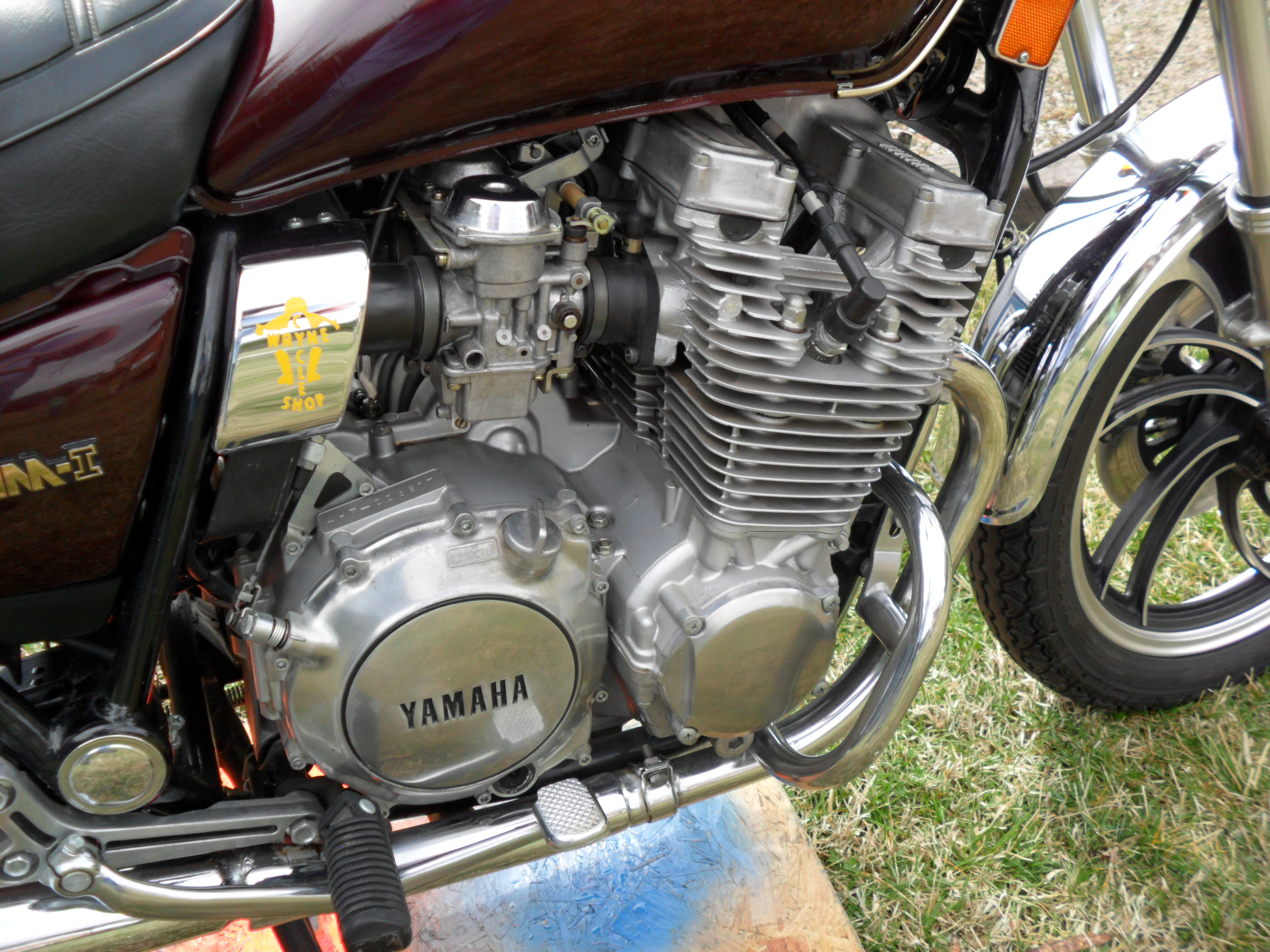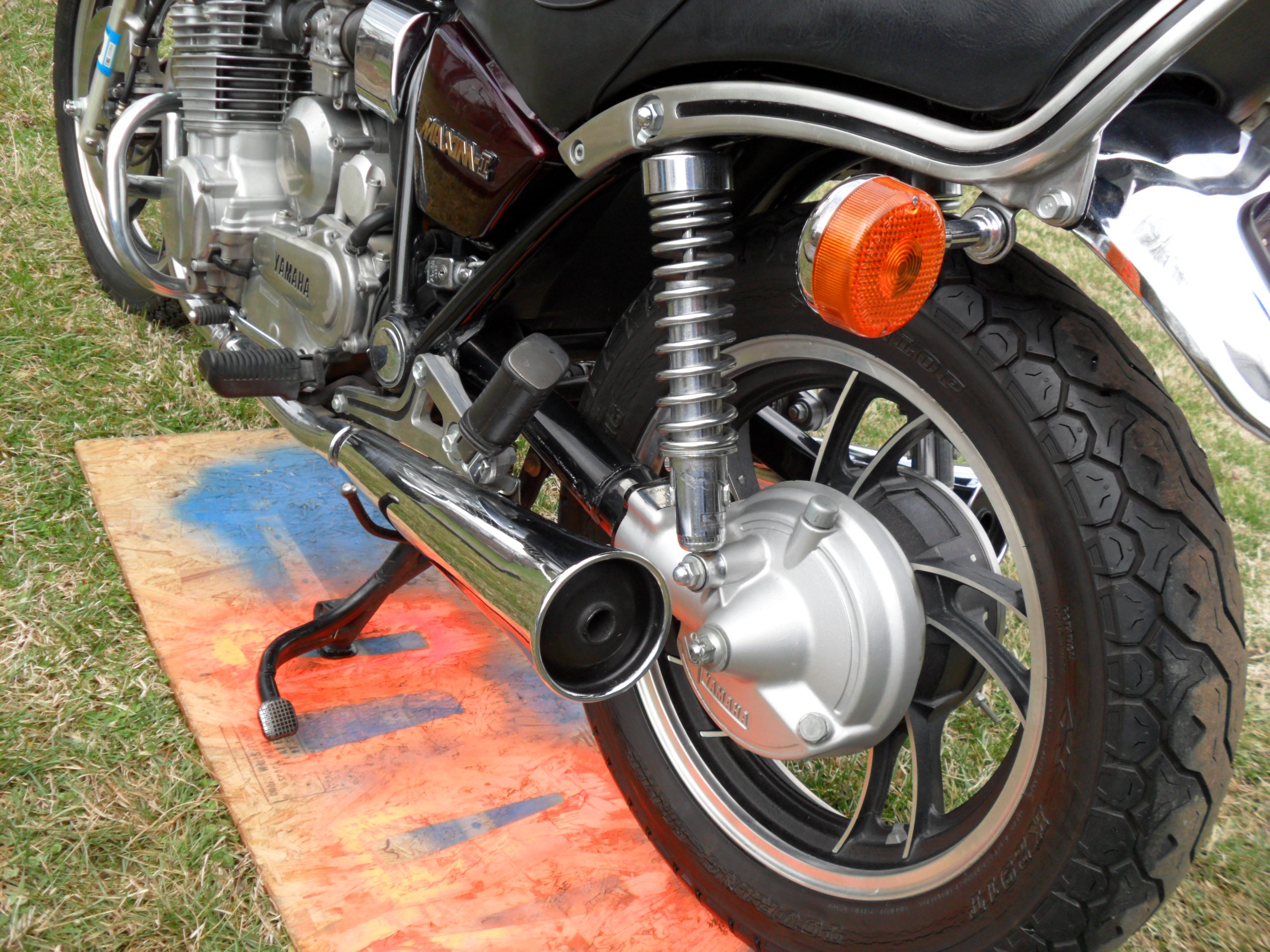Yamaha XJ650 Maxim on:
[Wikipedia]
[Google]
[Amazon]
The Yamaha XJ650 Maxim is a mid-size
 The 4 cylinder,
The 4 cylinder,

 The 1980 to 1983 XJ650 Maxim combined an air-cooled, 653 cc DOHC two valves per cylinder transverse
The 1980 to 1983 XJ650 Maxim combined an air-cooled, 653 cc DOHC two valves per cylinder transverse
motorcycle
A motorcycle (motorbike, bike, or trike (if three-wheeled)) is a two or three-wheeled motor vehicle steered by a handlebar. Motorcycle design varies greatly to suit a range of different purposes: long-distance travel, commuting, cruising ...
by the Yamaha Motor Company
is a Japanese multinational manufacturer of motorcycles, marine products such as boats and outboard motors, and other motorized products. The company was established in 1955 upon separation from Yamaha Corporation (however, Yamaha Corporation ...
introduced in 1980 as the Maxim I and produced through 1983. Yamaha designed the high-performance XJ650 as a brand-new four-cylinder with shaft drive, and built it specifically as a special cruiser
A cruiser is a type of warship. Modern cruisers are generally the largest ships in a fleet after aircraft carriers and amphibious assault ships, and can usually perform several roles.
The term "cruiser", which has been in use for several hu ...
. The XJ Maxim was the successor of the XS Special introduced in 1978.
History
Overview
 The 4 cylinder,
The 4 cylinder, air-cooled
Air-cooled engines rely on the circulation of air directly over heat dissipation fins or hot areas of the engine to cool them in order to keep the engine within operating temperatures. In all combustion engines, a great percentage of the heat ge ...
, twin-cam 650cc engine is housed in a cross-braced duplex steel tube frame. Yamaha made the engine narrower by locating the alternator
An alternator is an electrical generator that converts mechanical energy to electrical energy in the form of alternating current. For reasons of cost and simplicity, most alternators use a rotating magnetic field with a stationary armature.Go ...
behind the cylinder block
In an internal combustion engine, the engine block is the structure which contains the cylinders and other components. In an early automotive engine, the engine block consisted of just the cylinder block, to which a separate crankcase was attac ...
and above the gearbox rather than on the end of the crankshaft. The Maxim had shaft drive
A drive shaft, driveshaft, driving shaft, tailshaft (Australian English), propeller shaft (prop shaft), or Cardan shaft (after Girolamo Cardano) is a component for transmitting mechanical power and torque and rotation, usually used to connect ...
. Contemporary reports praised the Maxim's performance and braking. Criticism was aimed at engine vibration and under-damped suspension. Succeeding Maxim models were refinements; the 1982 Maxim 650 had a more comfortable handlebar, an air-adjustable fork, and a more luxurious seat. A turbocharged variant, the XJ650 Seca Turbo, was featured in the 1983 James Bond
The ''James Bond'' series focuses on a fictional British Secret Service agent created in 1953 by writer Ian Fleming, who featured him in twelve novels and two short-story collections. Since Fleming's death in 1964, eight other authors have ...
film ''Never Say Never Again
''Never Say Never Again'' is a 1983 spy film directed by Irvin Kershner. The film is based on the 1961 James Bond novel '' Thunderball'' by Ian Fleming, which in turn was based on an original story by Kevin McClory, Jack Whittingham, and Flemi ...
''.
'' Cycle'' magazine said in 1982 "Three years later, after the wide proliferation of special styling, it's easy to forget what a landmark bike the Maxim was...The 650 was striking, controversial, sensational, and wildly successful in showrooms. Other companies have produced bodacious knock-offs of the 650 Maxim, imitations that suffer from excess. It's too bad the Maxim was obscured when manufacturers blanketed the market with cruisers. A decade down the road, the Maxim may well be a genuine classic of the 1980s — a bright idea that stood the test of time."Quote-Cycle, 1982
Engine/Drivetrain

 The 1980 to 1983 XJ650 Maxim combined an air-cooled, 653 cc DOHC two valves per cylinder transverse
The 1980 to 1983 XJ650 Maxim combined an air-cooled, 653 cc DOHC two valves per cylinder transverse inline-four engine
A straight-four engine (also called an inline-four) is a four-cylinder piston engine where cylinders are arranged in a line along a common crankshaft.
The vast majority of automotive four-cylinder engines use a straight-four layout (with the ...
and shaft drive
A drive shaft, driveshaft, driving shaft, tailshaft (Australian English), propeller shaft (prop shaft), or Cardan shaft (after Girolamo Cardano) is a component for transmitting mechanical power and torque and rotation, usually used to connect ...
. The engine employed a one-piece crankshaft with plain bearings and placed the alternator and starter behind the engine to minimize width. A chain drives the two overhead camshafts, which used shim-and-bucket adjustment. A second chain drives the oil pump located in the crankcase
In a piston engine, the crankcase is the housing that surrounds the crankshaft. In most modern engines, the crankcase is integrated into the engine block.
Two-stroke engines typically use a crankcase-compression design, resulting in the fuel/a ...
, while a third (Hy-Vo) chain spins the alternator. The power unit is fed by four Hitachi
() is a Japanese multinational corporation, multinational Conglomerate (company), conglomerate corporation headquartered in Chiyoda, Tokyo, Japan. It is the parent company of the Hitachi Group (''Hitachi Gurūpu'') and had formed part of the Ni ...
constant velocity carburetors
A carburetor (also spelled carburettor) is a device used by an internal combustion engine to control and mix air and fuel entering the engine. The primary method of adding fuel to the intake air is through the venturi tube in the main meterin ...
and lit by electronic ignition
An ignition system generates a spark or heats an electrode to a high temperature to ignite a fuel-air mixture in spark ignition internal combustion engines, oil-fired and gas-fired boilers, Rocket engine#Ignition, rocket engines, etc. The widest ...
. Four-into-two headers extracts the waste gases, which exit through two shortened muffler
A muffler (North American and Australian English) or silencer (British English) is a device for reducing the noise emitted by the exhaust of an internal combustion engine—especially a noise-deadening device forming part of the exhaust sys ...
s.
Hypoid gears and a shaft turns the rear wheel, with the shaft housing forming the left side swingarm
A swingarm, or "swinging arm" (UK), originally known as a swing fork or pivoted fork, is a single or double sided mechanical device which attaches the rear wheel of a motorcycle to its body, allowing it to pivot vertically. The main component of ...
.
See also
*List of Yamaha motorcycles
List of motorcycles manufactured by Yamaha Motor Company.
First bikes
* YA-1 built August 1954, produced January 1955. The first bike manufactured by Yamaha was actually a copy of the German DKW RT 125; it had an air-cooled, two-stroke, single ...
References
External links
{{Yamaha motorcycles XJ650 Maxim Cruiser motorcycles Motorcycles introduced in 1980 Shaft drive motorcycles